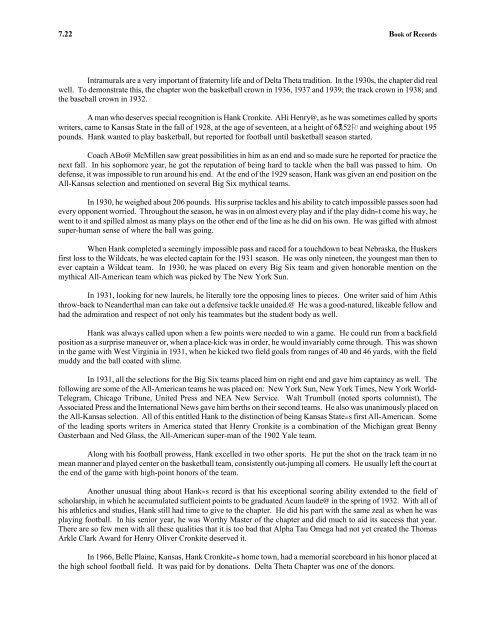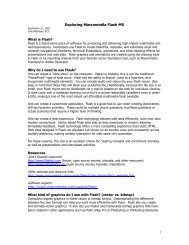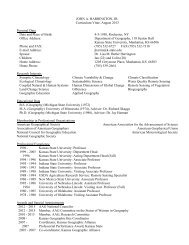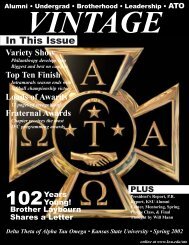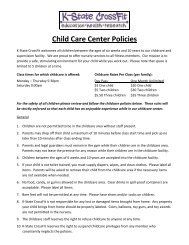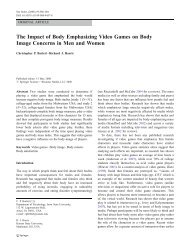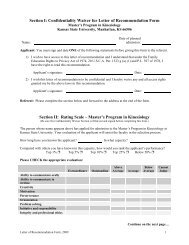book of records - Kansas State University
book of records - Kansas State University
book of records - Kansas State University
You also want an ePaper? Increase the reach of your titles
YUMPU automatically turns print PDFs into web optimized ePapers that Google loves.
7.22 Book <strong>of</strong> Records<br />
Intramurals are a very important <strong>of</strong> fraternity life and <strong>of</strong> Delta Theta tradition. In the 1930s, the chapter did real<br />
well. To demonstrate this, the chapter won the basketball crown in 1936, 1937 and 1939; the track crown in 1938; and<br />
the baseball crown in 1932.<br />
A man who deserves special recognition is Hank Cronkite. AHi Henry@, as he was sometimes called by sports<br />
writers, came to <strong>Kansas</strong> <strong>State</strong> in the fall <strong>of</strong> 1928, at the age <strong>of</strong> seventeen, at a height <strong>of</strong> 652 and weighing about 195<br />
pounds. Hank wanted to play basketball, but reported for football until basketball season started.<br />
Coach ABo@ McMillen saw great possibilities in him as an end and so made sure he reported for practice the<br />
next fall. In his sophomore year, he got the reputation <strong>of</strong> being hard to tackle when the ball was passed to him. On<br />
defense, it was impossible to run around his end. At the end <strong>of</strong> the 1929 season, Hank was given an end position on the<br />
All-<strong>Kansas</strong> selection and mentioned on several Big Six mythical teams.<br />
In 1930, he weighed about 206 pounds. His surprise tackles and his ability to catch impossible passes soon had<br />
every opponent worried. Throughout the season, he was in on almost every play and if the play didn=t come his way, he<br />
went to it and spilled almost as many plays on the other end <strong>of</strong> the line as he did on his own. He was gifted with almost<br />
super-human sense <strong>of</strong> where the ball was going.<br />
When Hank completed a seemingly impossible pass and raced for a touchdown to beat Nebraska, the Huskers<br />
first loss to the Wildcats, he was elected captain for the 1931 season. He was only nineteen, the youngest man then to<br />
ever captain a Wildcat team. In 1930, he was placed on every Big Six team and given honorable mention on the<br />
mythical All-American team which was picked by The New York Sun.<br />
In 1931, looking for new laurels, he literally tore the opposing lines to pieces. One writer said <strong>of</strong> him Athis<br />
throw-back to Neanderthal man can take out a defensive tackle unaided.@ He was a good-natured, likeable fellow and<br />
had the admiration and respect <strong>of</strong> not only his teammates but the student body as well.<br />
Hank was always called upon when a few points were needed to win a game. He could run from a backfield<br />
position as a surprise maneuver or, when a place-kick was in order, he would invariably come through. This was shown<br />
in the game with West Virginia in 1931, when he kicked two field goals from ranges <strong>of</strong> 40 and 46 yards, with the field<br />
muddy and the ball coated with slime.<br />
In 1931, all the selections for the Big Six teams placed him on right end and gave him captaincy as well. The<br />
following are some <strong>of</strong> the All-American teams he was placed on: New York Sun, New York Times, New York World-<br />
Telegram, Chicago Tribune, United Press and NEA New Service. Walt Trumbull (noted sports columnist), The<br />
Associated Press and the International News gave him berths on their second teams. He also was unanimously placed on<br />
the All-<strong>Kansas</strong> selection. All <strong>of</strong> this entitled Hank to the distinction <strong>of</strong> being <strong>Kansas</strong> <strong>State</strong>=s first All-American. Some<br />
<strong>of</strong> the leading sports writers in America stated that Henry Cronkite is a combination <strong>of</strong> the Michigan great Benny<br />
Oasterbaan and Ned Glass, the All-American super-man <strong>of</strong> the 1902 Yale team.<br />
Along with his football prowess, Hank excelled in two other sports. He put the shot on the track team in no<br />
mean manner and played center on the basketball team, consistently out-jumping all comers. He usually left the court at<br />
the end <strong>of</strong> the game with high-point honors <strong>of</strong> the team.<br />
Another unusual thing about Hank=s record is that his exceptional scoring ability extended to the field <strong>of</strong><br />
scholarship, in which he accumulated sufficient points to be graduated Acum laude@ in the spring <strong>of</strong> 1932. With all <strong>of</strong><br />
his athletics and studies, Hank still had time to give to the chapter. He did his part with the same zeal as when he was<br />
playing football. In his senior year, he was Worthy Master <strong>of</strong> the chapter and did much to aid its success that year.<br />
There are so few men with all these qualities that it is too bad that Alpha Tau Omega had not yet created the Thomas<br />
Arkle Clark Award for Henry Oliver Cronkite deserved it.<br />
In 1966, Belle Plaine, <strong>Kansas</strong>, Hank Cronkite=s home town, had a memorial scoreboard in his honor placed at<br />
the high school football field. It was paid for by donations. Delta Theta Chapter was one <strong>of</strong> the donors.


